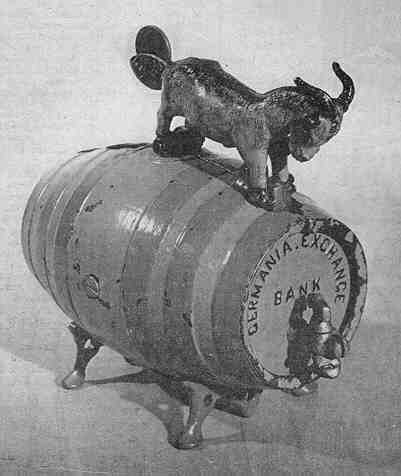Germania Exchange Bank
by F.H. Griffith - HOBBIES Magazine - March, 1952

In arriving at the selection of the mechanical bank which ranks in sixth position, again we are confronted with one of which there is little known as to actual origin, namely, the Germania Exchange Bank.
As is the case with some other top banks, there is no definite proof as to who manufactured or designed the bank, and again there is no patent information to trace. There are, however, certain salient features, such as the goat which is made in lead or white metal, and the general characteristics of the Germania Bank that would lead one to the top bank designer, namely Mr. Charles Bailey. It is known that Bailey made the Bismark Bank and this consists of a cast iron pig with a lead or white metal figure of Bismark popping out of the pig’s back. Also, since Mr. Bailey spent so much time at the Stevens Factory in Cromwell, Connecticut, we can assume that they manufactured the bank.
The bank shown was added to the writer’s collection through the good help of Mr. Mark Haber of Wethersfield, Connecticut, who obtained it from the late James C. Jones’ collection. Mr. Jones had in turn obtained it from the late Norman E. Sherwood who made a business some years back of selling mechanical banks to collectors.
So far all banks shown in these articles have been in original condition with no repairs. The bank pictured here has had some slight repairs made to the horns and one of the brackets holding the barrel. It might be well to point out here that in the case of rare banks, minor repairs of this nature do not greatly affect the value. The bank is painted in bright colors, the barrel being tan with red striping, the bracket feet are red, and the goat is painted in a realistic way with black tail and horns. To operate the bank, the coin is placed in the goat’s tail, then the handle on the spigot is turned. This causes the goat to rise on its hind legs, the coin automatically drops into the bank, and the goat stands up holding a gold mug in its two front paws.
For sometime there has existed a story that this particular bank was made years ago in celebration of a brewery party that was held at a hotel in St. Louis, Missouri. However, it is definitely the writer’s opinion that this was actually a mechanical bank manufactured for sale in stores, the same as the other mechanical banks. Some proof of this is brought out by the fact that the specimen owned by Mr. L.C. Hegerty is painted differently than that in the writer’s collection. The barrel and the supporting brackets on his specimen are japanned or lacquered and it was definitely painted this way originally. The painting on the Germania bank in Dr. Corby’s collection is identical to that in the writer’s collection. Had this bank been manufactured for any particular occasion as a one-time proposition all of them undoubtedly would have been painted alike. Then, too, had this bank been made for a special occasion to advertise a brewery, there would have been some other wording on the bank other than "Germania Exchange Bank", such as the name of the brewery or its product.
It is interesting to note that in Pittsburgh, Pennsylvania, there existed a Germania Savings Bank which was organized April 8, 1870 and went out of existence sometime in 1919. This bank originated through German-American extraction and could conceivably have some bearing on the manufacture and naming of the Germania Exchange mechanical bank.
There are four of these banks known to exist in private collections.
Germania Exchange Bank – Referring back to the article on the Germania Exchange Bank in the March issue, evidence supporting the opinion that this bank was not made for any special occasion or party has come forth in an interesting letter from Mrs. Harvey Warner of Michigan. It seems that her husband’s parents purchased a Germania Exchange Bank for him when he was a small boy, as she says in her letter "probably 50 or more years ago." The bank was purchased in a store in Cleveland, Ohio, and has been in his possession ever since.
This letter from Mrs. Warner substantiates the expressed opinion that the Germania Exchange Bank was sold as a commercial item in stores.
